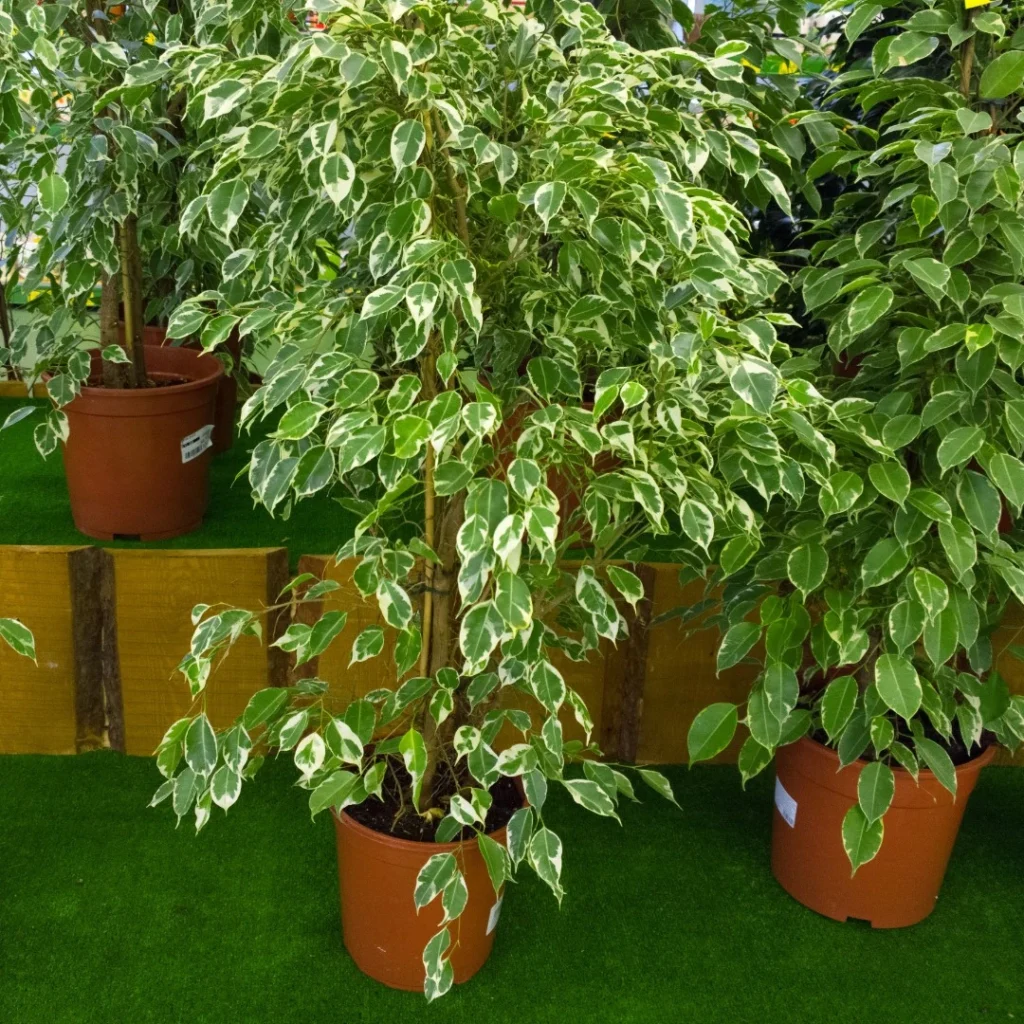
The Weeping Fig (Ficus benjamina) is a very popular tree, monoecious, native to Asia and Australia, and mainly used for indoor decoration. The genus name Ficus comes from the Latin ficus which literally means fig, referring to the fruit produced by species in the genus. The specific epithet benjamina has a controversial origin, but some sources mention a relation with the Sanskrit word bani or banyan (banjilin), which refers to a type of tree that forms new trunks from aerial roots that touch the ground, although this species is not a true banyan. Another reference may be related to the Hebrew Bīnyāmīn (benjamin), which means son of the right hand or son of happiness, perhaps an allusion to the species’ ease of vegetative propagation.
With a grayish stem, aerial roots, and pendulous branches, it has a moderate to rapid growth rate and, under natural conditions, can reach 30 meters in height. Its leaves are small, shiny, and evergreen, with a green or variegated white or yellow coloration. They are elliptical with an acuminate tip and have slight undulations on the edges. The inconspicuous white flowers have no ornamental value. The small, red fruits are decorative and attract birds. Its aggressive and superficial roots are attention-grabbing, and they often crack pots and pavements.

The Weeping Fig is a beautiful tree, widely used in landscaping. It is recommended to plant this fig tree individually in extensive gardens and farms, where the sculptural aspect of the stem stands out. Planted in pots, it can also be grown as a small tree or shrub. Its flexible stem allows for braiding when young, giving it a special charm. Additionally, because it is highly branched and has dense foliage, it is sought after for topiary work, acquiring beautiful rounded and compact shapes. Its characteristics, such as the sculptural stem and small leaves, also make it very suitable for bonsai art.
The species Ficus benjamina has numerous cultivars, some of which are widely used indoors, such as ‘Danielle’, ‘Naomi’, ‘Exotica’, ‘Wiandi’, ‘Esther’, ‘Nicole’, and ‘Golden King’. They have different leaf coloration patterns, ranging from light green to dark green, and various variegation forms. In the UK, both the species and the variegated cultivar ‘Starlight’ have received awards from the Royal Horticultural Society. Miniature cultivars, especially ‘Too Little’, are among the most popular for bonsai, due to their compact size and delicate foliage. In addition to those mentioned, other cultivars include ‘Golden Princess’, with light green and yellowish leaves, ‘Monique’, with dark green leaves and wavy edges, and ‘Barok’, with curled leaves.

Unfortunately, due to its popularity, Weeping Fig Trees have been planted in improper locations, such as on sidewalks, streets, and near walls and buildings. As the tree develops, its superficial roots thicken and cause significant damage to structures and underground pipes, leading to its prohibition in various cities. Frequent pruning of branches controls both aerial and root growth since the root system reflects the above-ground part of the plant. However, caution is advised when pruning Weeping Fig Trees, as their milky sap is toxic and can cause skin irritations and allergies, especially in sunlight. Therefore, it is ideal to wear protective gloves when handling the tree, and if sap comes into contact with the skin, it should be washed off promptly.

Managing Ficus benjamina indoors requires special attention, as the plant is sensitive to changes. When turned or relocated, it is common for it to shed many of its leaves, replacing them with new ones that adapt to the new light intensity. Additionally, Ficus benjamina is sensitive to changes in other environmental factors, such as temperature, humidity, and changes in location, requiring care to maintain its healthy development.
Regarding pests, it is worth mentioning that this species is also highly sensitive to thrips, which can be easily diagnosed by the closed appearance of the leaves. Upon opening the closed leaves, different stages of thrips can be observed. For treatment, it is ideal to prune, removing a good portion of the affected leaves, followed by the application of an insecticide, with a 5-day interval between applications.
It should be grown in full sun or partial shade, in fertile, well-drained soil enriched with organic matter, and regularly irrigated. In brighter environments, such as indoors, it tends to have fewer leaves than when grown in full sun. It is quite hardy, but when planted in pots indoors (homes, offices), it does not appreciate changes in location, drafts, over-watering, and air conditioning. When stressed by these factors, it is common for its leaves to turn yellow and fall off, but it can regrow vigorously once the problem is resolved. Potted plants should be fertilized monthly in spring and summer and transplanted into a larger pot once a year. They propagate by hardwood cuttings and seeds. Its height can be reduced through the air layering technique.



